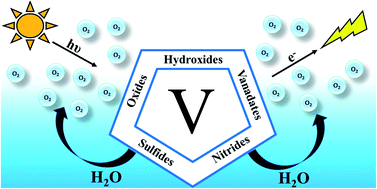Vanadium-containing electro and photocatalysts for the oxygen evolution reaction: a review
Abstract
The frenetic global development is improving the average quality of life in an unprecedented way, but at the expense of increasing pressure on natural resources, environmental pollution and energy demand, which are being exacerbated by population growth and industrialization in developing countries. The energy demand probably is the one contributing the most to such a situation, thus urging the development of clean and renewable alternative energy sources in order to avoid an imminent energy crisis in the near future. A possible solution is a society in which most energy needs are fulfilled by photoinduced or electrochemical water-splitting, storing solar energy as hydrogen and dioxygen gas, and releasing the chemical energy in fuel cells while regenerating water. However, the oxygen evolution reaction (OER) and the oxygen reduction reaction taking place respectively in water-splitting and fuel cells are quite sluggish because of their multielectronic and multiprotonic nature. Catalysts such as IrO2 and RuO2 are being successfully used as state-of-the-art OER electrocatalysts but such noble metal-based materials are severely limited by their scarcity and high cost. Thus, noble metal free electro/photocatalysts are being eagerly pursued to provide more sustainable alternatives. In this context, vanadium-based and vanadium-containing electro and photocatalysts based on hydroxides/oxyhydroxides/oxides, vanadates, chalcogenides and nitrides stand out among the most promising alternatives, and recent advances have demonstrated their key role in enhancing the catalytic activity by strong synergic electronic and structural effects. In fact, such high-performance materials have potential in the fabrication of fuel cells and photosynthetic devices competitive enough in converting chemical energy into electricity and solar energy into solar fuel, enabling large-scale production, storage and usage of the infinite energy of the sun in a more convenient and safe manner. Perspectives are also provided on the preparation, evaluation of synergic effects in OER electro/photocatalytic activity, and their correlation with the electronic and crystalline structure of the materials, as well as on the electrode material design.



 Please wait while we load your content...
Please wait while we load your content...